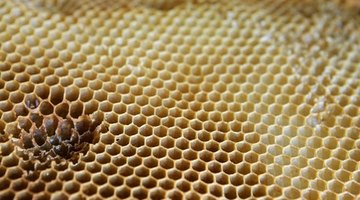How to Remove a Honeycomb
While watering your backyard, if you hear a strange buzzing noise that seems to be coming from your attic's air vent, you may be shocked to discover a swarm of bees hovering around the vent, entering and exiting at their leisure. Before dousing the entire attic in pesticide and leaving it at that, realize that you must also remove the root of the bee infestation: the honeycomb. The honeycomb is the bee colony's main source of refuge and honey storage, so ridding your attic of it is the best way to prevent future visits.

-
Put on your face mask, safety goggles and thick work gloves. Also wear a thick layer of clothing that covers as much of your skin as possible.
-
Locate the honeycomb by tracking the swarming bees. If the honeycomb is in a precarious location, such as in your garage's air vent, access it from the inside of the structure rather than the outside.
-
Spray the honeycomb with pesticide from at least 10 feet away. Continue spraying until the bees begin to drop and expire. If you own or can borrow a bee smoker machine, it will help calm the bees before pesticide application.
-
Allow the honeycomb to settle overnight. If you see any stray bees, eliminate them with pesticide.
-
Chip away large pieces of the empty honeycomb with a trowel tool. Scrape away any stuck fragments with the edge of the tool. Place the honeycomb in a large garbage bag.
-
Sweep up the dead bees and any loose honeycomb particles from the ground. Empty the dustpan into the garbage bag.
-
Pour all-purpose cleaner and warm water into a plastic bucket. Saturate a scrub brush with the solution and clean away any wax and dried honey from the area. Dry with a towel.
Check out this related video from Homesteady on Youtube.
References
Tips
- If the honeycomb is located between two walls, you may wish to contact a professional bee removal service. Removal of this type of colony can be dangerous and labor intensive.
Warnings
- Do not attempt to exterminate the bee colony if you or a family member are allergic to bee stings. Contact a professional bee removal service immediately.
Writer Bio
Brandon Getty began writing professionally in 2008, with columns appearing in "Thrasher" magazine. He received a Bachelor of Arts in literature from the University of California, Santa Cruz, and lives in Stockton, Calif.
Photo Credits
- honeycomb image by Andrzej Solnica from Fotolia.com
More Articles



